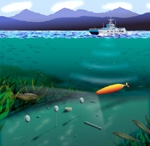 Norwegian subsea technology is behind one of the hottest items of news in the international press. While on a surveying job in the Gulf of Mexico, BP and Shell made a sensational find: a German submarine at a depth of 1500 metres. The vessel was sunk by the US Navy in July 1942. The find was explored using a Hugin 3000 (semi-submersible) developed by Kongsberg Gruppen's subsidiary Kongsberg Simrad. Some historians have had a theory that there might be a submarine wreck located that close to the American mainland. The discovery of this German U-166 submarine proves them right, and WWII history books will have to be revised, writes tekblad.no.
Norwegian subsea technology is behind one of the hottest items of news in the international press. While on a surveying job in the Gulf of Mexico, BP and Shell made a sensational find: a German submarine at a depth of 1500 metres. The vessel was sunk by the US Navy in July 1942. The find was explored using a Hugin 3000 (semi-submersible) developed by Kongsberg Gruppen's subsidiary Kongsberg Simrad. Some historians have had a theory that there might be a submarine wreck located that close to the American mainland. The discovery of this German U-166 submarine proves them right, and WWII history books will have to be revised, writes tekblad.no.
Norwegian engineers behind the vessel
It was the US surveying company C&C Technologies that made the discovery while on assignment for the oil companies. They were using the Hugin 3000, one of the world's first autonomous underwater vehicles - AUVs . The international media credited C&C for having developed the sophisticated vessel, but the truth is that Norwegian engineers are behind it. The company acquired the vessel from Kongsberg Simrad in Horten, which has designed and built it in collaboration with the Defence Research Establishment (FFI) at Kjeller.
"We are pleased about the incident, and that our semi-submersible has played a part", remarked Product Manager Karstein Vestgård of Kongsberg Simrad to tekblad.no.
 The Hugin 3000 is a further development of the NUI Explorer (Hugin II), which Statoil and Hydro have been using on the Continental Shelf since 1997. FFI came up with the idea and initiated the project, developing the battery technology and not least the exceptionally sophisticated navigation system. Kongsberg Simrad is responsible for the acoustic sensors, control/steering system and most of the electronics.
The Hugin 3000 is a further development of the NUI Explorer (Hugin II), which Statoil and Hydro have been using on the Continental Shelf since 1997. FFI came up with the idea and initiated the project, developing the battery technology and not least the exceptionally sophisticated navigation system. Kongsberg Simrad is responsible for the acoustic sensors, control/steering system and most of the electronics.
Vestgård reports that an AUV has some major advantages over a traditional ROV (remotely operated vehicle), which is remotely controlled through a cable. The main advantage is its speed: Up to four knots, while an ROV can only reach a speed of one knot at that depth.
"This is because an ROV has such a large voltage drop in the cable at that depth", explains Vestgård. An AUV is also better at navigating undulating and difficult underwater routes which pose heavy demands to the vessel's manoeuvrability.
The world's first
"The Hugin 3000 is the first vessel of its kind to be sold on the international market", emphasises Vestgård.
He points out that the sale to C&C Technologies took place against keen competition, and that they were awarded the contract because they could document that their technology was the best and most advanced. The navigation system from FFI weighed heavily in the decision, as it contains some of the most sophisticated technology on the market.
"C&C worked with us during most of the design phase, posing strict requirement specifications."
He would not reveal the price of the vessel, but intimates that a "basic version" costs MNOK 30 to 40.
Hoping for a market break "We hope this sale and not least this incident will open other markets", adds Research Director Nils Størkersen of FFI, the man in charge of the project.
They need a commercial, civilian success to develop the vessel for military applications. Størkersen mainly has submarine mine-hunting and mine clearance in mind. And the preparation of accurate maps of the seabed.
Related links : www.cctechnol.com/U166.htm uboat.net C&C Technologies